Column: Do Californians want solar and wind in their backyards? New poll says yes
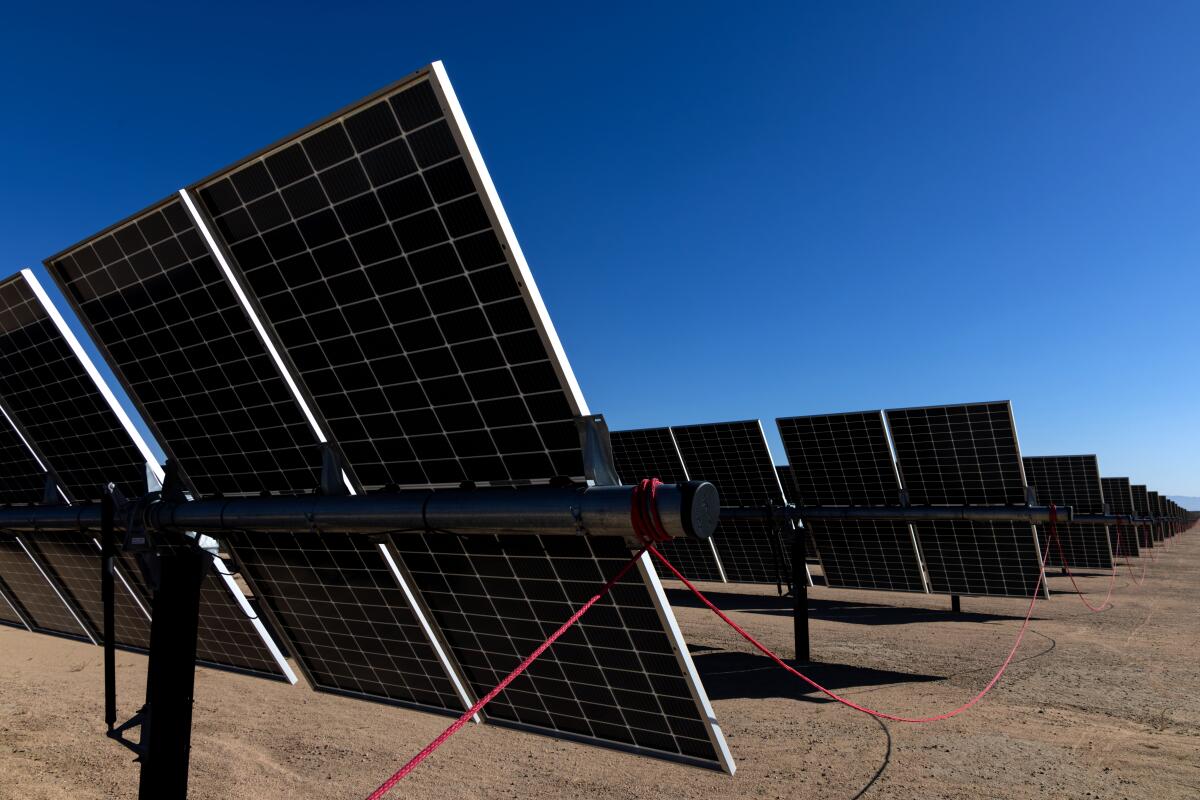
For all the opposition to wind turbines and solar farms bubbling up across California, most Golden State voters would have no objection to a renewable energy project in their backyard.
That’s according to a new poll co-sponsored by the L.A. Times and conducted by UC Berkeley’s Institute of Governmental Studies. Pollsters found that 56% of registered voters would be comfortable with wind turbines near their community, compared with 32% opposed. Solar farms earned an even stronger endorsement, with 69% of respondents supportive and 22% opposed.
Voters also gave their blessing to offshore wind turbines visible from the beach by a 2-1 ratio — a promising finding for an industry facing pushback from some coastal residents and conservationists as it seeks to get started on the Pacific shore.
Electric transmission lines — which are needed to move climate-friendly energy from wind and solar farms where it’s generated to cities where it’s needed — received a less favorable hearing. Just 42% of registered voters told pollsters they’d be comfortable living near a long-distance power line, with 39% opposed.
Overall, though, the results reveal an electorate ready and willing to live alongside clean energy infrastructure, and help avert the worst ravages of the climate crisis, in the world’s fifth-largest economy.
The rest of the U.S. appears similarly ready. A recent national poll by the Washington Post and the University of Maryland found that 75% of Americans would be comfortable living near a solar farm, and 68% near a wind farm.
Those are encouraging numbers. But they don’t tell the full story.
“There’s this mismatch between broad public support and specific intense opposition,” Leah Stokes told me.
Stokes is a political scientist at UC Santa Barbara and the lead author of a recent study examining opposition to wind turbines in the U.S. and Canada. After a decade of research — during which 20 undergraduates pored over nearly 36,000 news articles — she and the team found that 17% of proposed wind farms faced significant opposition in the U.S. between 2000 and 2016.
The opposition was strongest in areas with whiter populations — a phenomenon that Stokes and her co-authors deemed “energy privilege,” because blocking or delaying renewable energy installations can lead to continued pollution of lower-income communities of color, where fossil-fueled power plants have disproportionately been built.
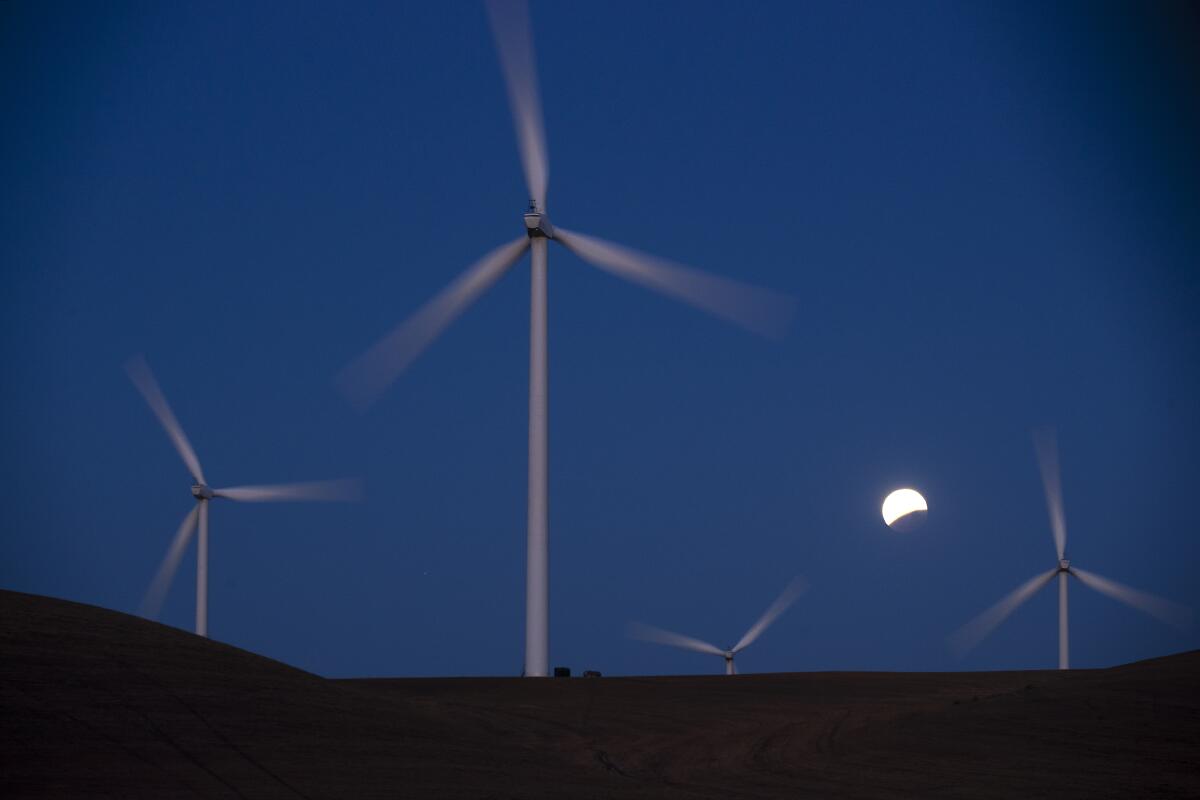
When I told Stokes that The Times had co-sponsored a poll asking people about wind and solar farms near where they live, she immediately guessed the numbers had shown broad support. There have been lots of similar findings, she said.
But the reality is that opponents of big wind and solar installations are often the loudest people in the public sphere. It doesn’t take too many of them to persuade a county board of supervisors to block a renewable energy project — or to ban all projects.
“You’re subverting the democratic will of the people, that they want to stop using fossil fuels,” Stokes said.
I’ve seen this pattern play out across the country, from the Northern California county that recently launched a $100,000 media campaign to stir up opposition to a wind farm, to conservation activists urging the Biden administration to reject solar facilities in the Nevada desert, to landowners fighting a solar project in rural Ohio with such intensity that the developer backed out.
Some of the reasons people have opposed renewable energy facilities in their backyards are understandable, including concerns over local environmental impacts, harm to sacred tribal lands and a general feeling of industrialization — especially in rural towns where people love the wide-open views. Other reasons are less valid, including fears that wind turbines will give people cancer, or that solar farms will heat up their communities — misinformation propped up at times by fossil fuel industry money.
Whatever the source of the opposition, we’ve collectively got to find ways to sort through it, and stop burning fossil fuels as rapidly as possible. If we don’t want to see regular variations on the Camp fire, which destroyed the town of Paradise — or heat waves far more punishing than the ones of the last few summers, or drought restrictions far more serious than we’ve yet to experience, or sea level rise that gobbles up our favorite beaches — we’ve got to build a lot more renewable energy, a lot faster.
In some ways, Southern California’s San Bernardino County is ground zero for figuring that out.
It’s been almost five years since the county — the state’s largest by land area — banned large solar and wind farms across more than 1 million acres of private land. I visited a few days before the county supervisors’ 4-1 vote, talking with locals who made the case that solar farms would kill sensitive animals and plants, fuel dust storms and disrupt their quiet, rural lifestyles.
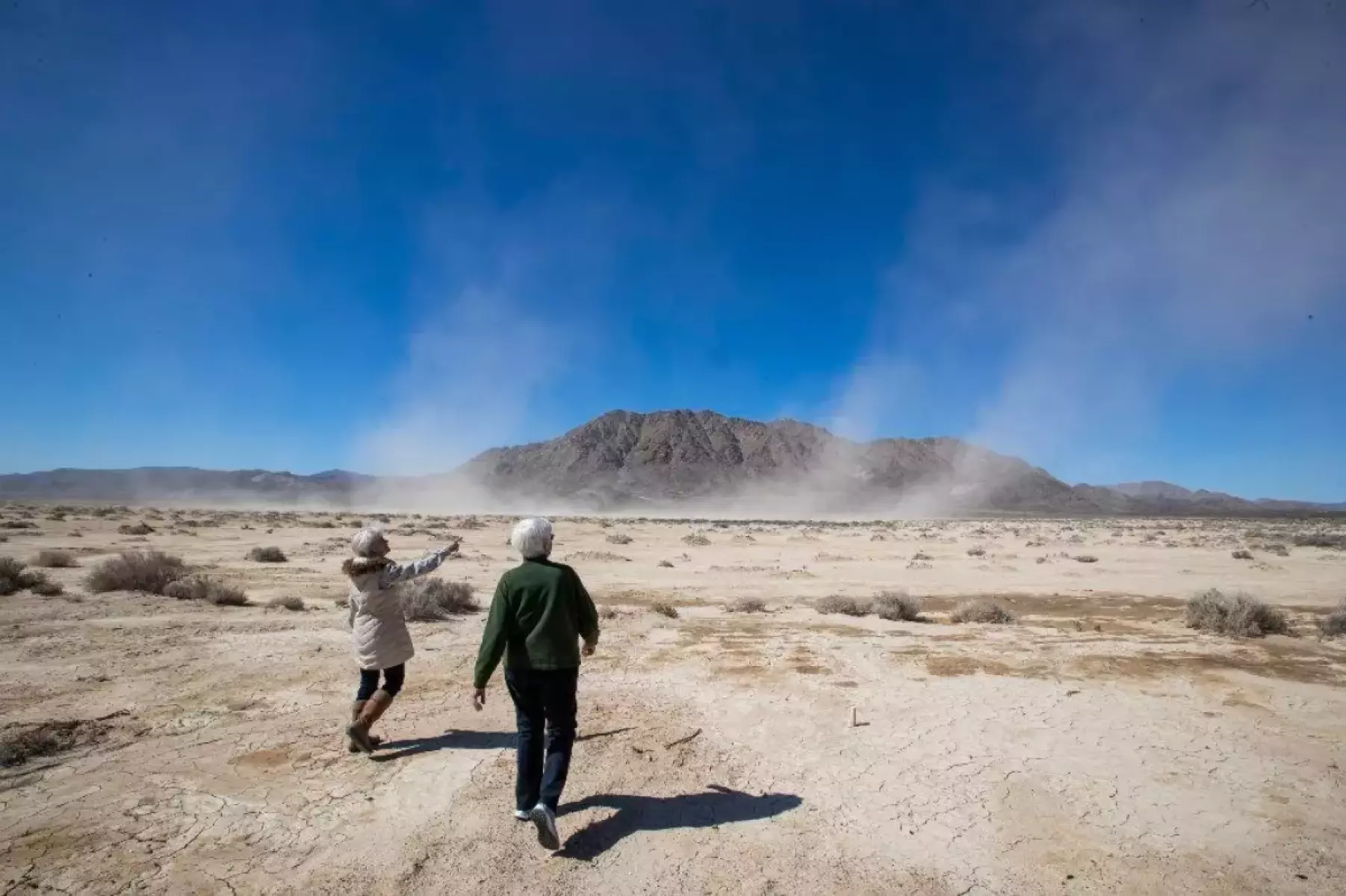
Fortunately for Clearway Energy Group, the company’s proposal for a huge solar farm just outside Barstow — a high desert town known to many Angelenos as a stopping point on the way to Las Vegas — fell mostly outside the area cordoned off by the county. Clearway held a ribbon-cutting ceremony last month for its 482-megawatt Daggett project, which also includes 1,120 megawatt-hours of battery storage that will help keep the lights on after dark for homes and businesses across the state.
James Kelly, the Clearway executive who led the project’s development, told me the company saw plenty of support for the construction jobs the solar farm would bring. And Daggett has other benefits too. It has replaced agricultural land where farmers were over-pumping the area’s groundwater aquifer to grow alfalfa for cattle feed, Kelly said. And the clean electricity the solar panels generate will help make up for the 2015 closure of a gas plant next door.
But some locals still fought the project’s approval. Kelly spent years meeting with nearby residents and county officials, trying to figure out what steps his San Francisco-based employer could take to mollify critics. He also attempted to dispel misinformation spread by project opponents, such as rumors that the 6-foot solar panels would be three times that size.
The spread of false claims “was almost like a game of telephone,” he said.
The company ended up agreeing to build solar panels and batteries farther away from some rural homes than initially proposed, and to take “extensive mitigation measures” to help keep dust from blowing into nearby communities, Kelly told me.
San Bernardino County supervisors ultimately approved Daggett in a unanimous vote. It’s now one of the nation’s largest operating solar-plus-storage projects — and Julia Zuckerman, Clearway’s Western head of external affairs, is hopeful it will show people that solar is not a bad neighbor.
“Having the chance to see the project completed, and see what a solar project of that size looks like in real life — we hope that will help change the environment in which the county is thinking about solar,” she said.
I choose to be hopeful, too. Sure, more people are fighting over solar and wind farms than ever before — but the more of these facilities get built, the more opportunities we’ll have to get used to living with them, too.
It’s also encouraging that a growing number of experts and climate activists are getting creative as they work to bridge the divide between clean power supporters and opponents. Just this week, I was fascinated to learn about an MIT professor teaching a class in conflict mediation for renewable energy projects.
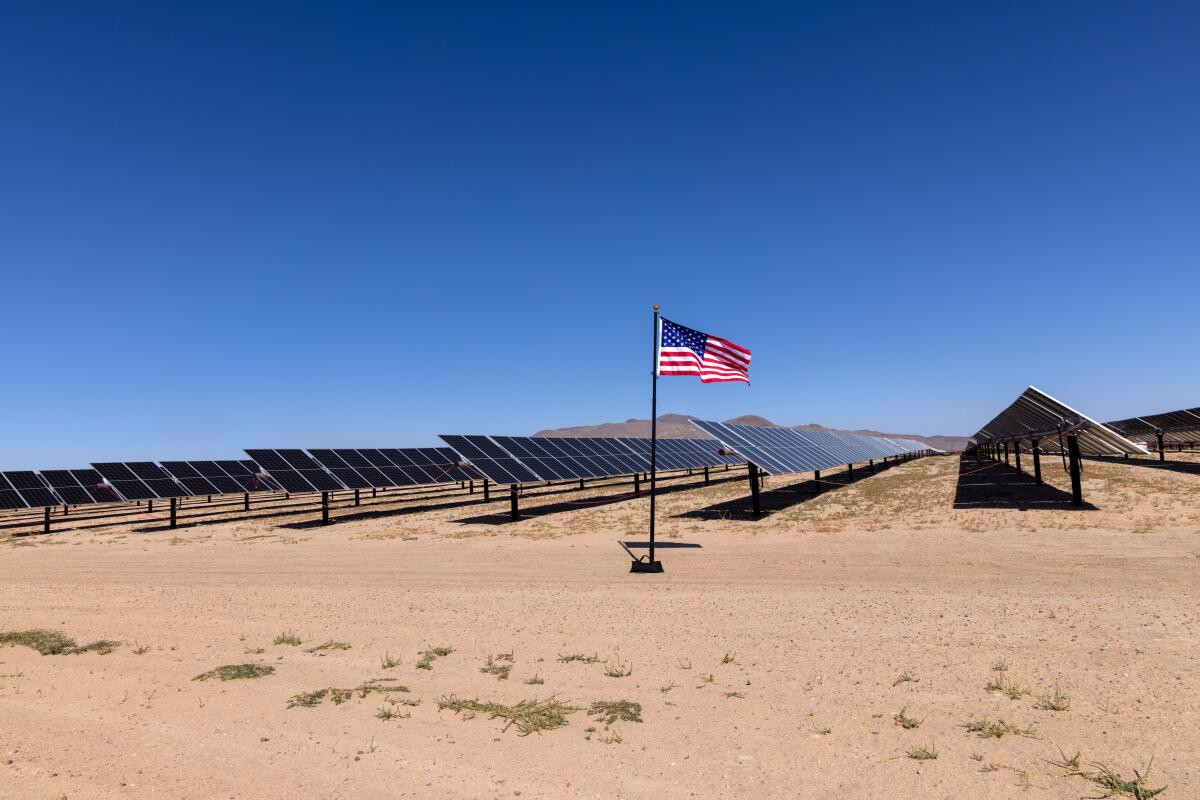
If I’m discouraged by any of our new poll’s findings, it’s the narrow margin of support for long-distance power lines.
Hardly anybody likes looking at electrical wires, strung across looming steel towers that cascade through neighborhoods and interrupt rural landscapes. But there’s practically no way to keep global warming to less-than-catastrophic levels without a lot more of those wires.
Take California as an example. Right now, the Golden State has just over 80 gigawatts of electric generating capacity. To achieve 100% clean energy, state agencies envision adding 70 gigawatts over the next decade, and an additional 50 gigawatts by 2045 — in other words, more than doubling the size of the electric grid. We’ll need all that clean power not only to keep our lights on and refrigerators humming, but also to transition to electric cars, electric cooking and electric heating in our homes.
Why is it that just 42% of California voters would be fine living near a power line, compared with 56% for wind turbines and 69% for a solar farm? Our poll doesn’t answer that question. But Stokes, the UC Santa Barbara professor, has a theory. She pointed to a long history of false and exaggerated claims linking electric lines to serious health problems.
“People think power lines give them cancer because of all of that misinformation,” she said.
One reason public skepticism of power lines is so dangerous is because it already takes far too long to secure permission to build this critical infrastructure. The TransWest Express line — which is designed to carry wind energy from Wyoming to California, and whose planned route I traveled last year — has been in the works for more than 15 years. In the Pacific Northwest, Idaho Power is preparing to start building a 290-mile line that would carry wind and hydropower — 17 years after it was first proposed.
“We’ve got to fix permitting, because it shouldn’t take 17 years,” said Lisa Grow, Idaho Power’s chief executive.
But when I sat down with Grow during a reporting trip to Boise earlier this year, she also emphasized the importance of hearing people out along power-line routes. Early in the development of the 290-mile Boardman-to-Hemingway line, she said, she talked with a farmer who worried that electromagnetic fields from the wires could interfere with the navigational abilities of bees that pollinate his crops. She described working with him to assuage his concern and take steps to address it.
Some power-line critics “just don’t want it because they don’t want it. And I’m not sure we can help on that,” Grow said. “But for people that have specific needs, I think it is worth the time to have a process where they can be invited in, and you can deal with some of those things upfront. If you wait until the end, you just have a fight.”
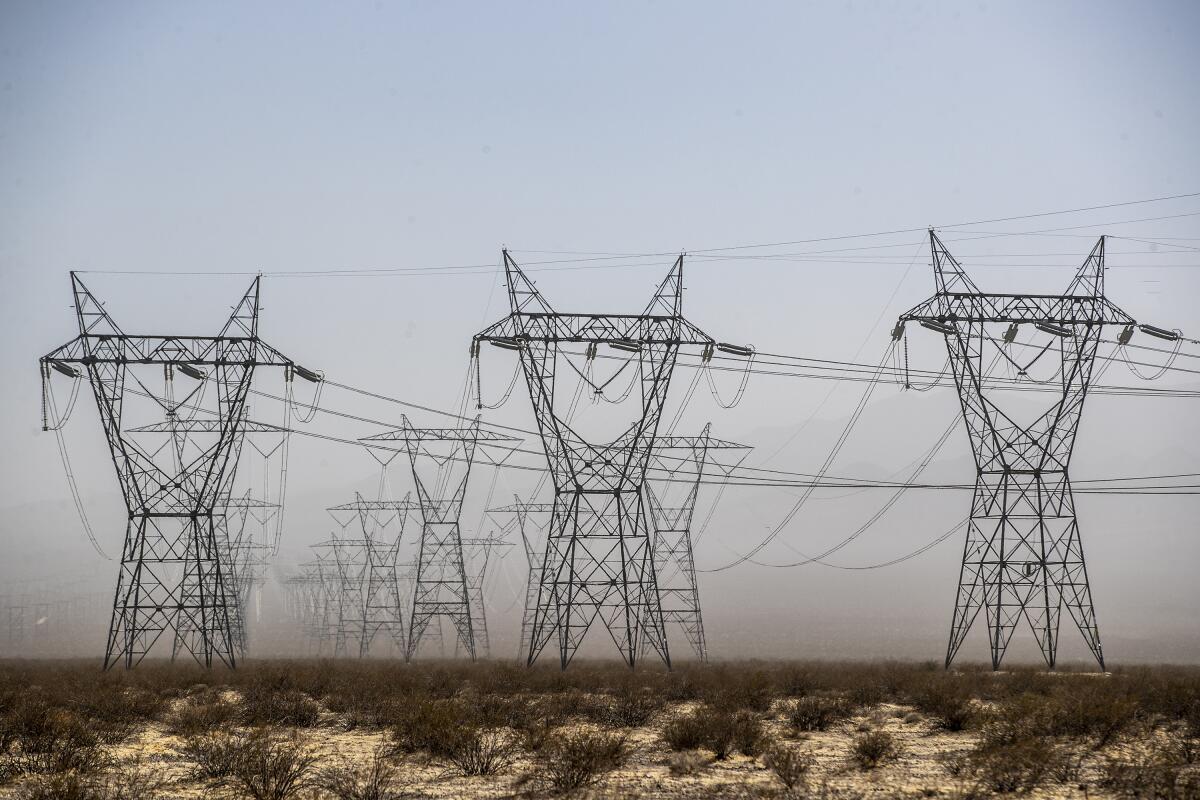
You may be wondering about the potential for rooftop solar to solve our climate and air pollution problems, and negate the need for all these electric lines and wind turbines and solar panels slung across the landscape. The short version — as I’ve written previously — is that we don’t have nearly enough rooftops to replace all the fossil fuels we currently burn.
The long version, though, is that more rooftop solar should result in less need for the controversial stuff, at least on the margins. And right now, California is one of many states making it harder for rooftop solar to get around its main stumbling block.
That stumbling block is price.
In our new poll, homeowners without rooftop panels cited high installation costs as the most common reason they haven’t gone solar. Thirty-seven percent said they couldn’t afford it, with the percentage rising even higher among low-income homes.
I wouldn’t be surprised to see those numbers grow, given that Gov. Gavin Newsom’s appointees voted last year to sharply reduce incentive payments for rooftop solar — a change that has already prompted a steep drop-off in new installations.
The outlook may yet get worse. Newsom’s appointees on the Public Utilities Commission are considering a proposal to slash solar incentives for apartment renters, schools and farms, significantly cutting the rate at which they’d be compensated by utility companies Southern California Edison, Pacific Gas & Electric and San Diego Gas & Electric for electricity they generate.
That such a proposal is being considered is immensely frustrating for Matthew Jacobs, a principal at real estate investment firm BLDG Partners. At the Knolls, a 260-unit affordable housing community in Orange County, his company recently partnered with solar installer Sunrun to blanket the parking areas with 1,596 panels. Those panels, Jacobs told me, will save the average renter $60 per month.
“If you’re saving $60 a month times twelve, that is $700 of food, medicine, transportation,” he said.
Those savings are made possible largely by “virtual net metering” — the state incentive program now on the chopping block, with a vote slated for Nov. 16. The proposal wouldn’t affect low-income apartments like the Knolls, where families would still be eligible for higher payments. But the changes would affect new solar developments at market-rate apartments.
“If they get rid of it for market rate, I don’t see how you can make it work,” Jacobs said.
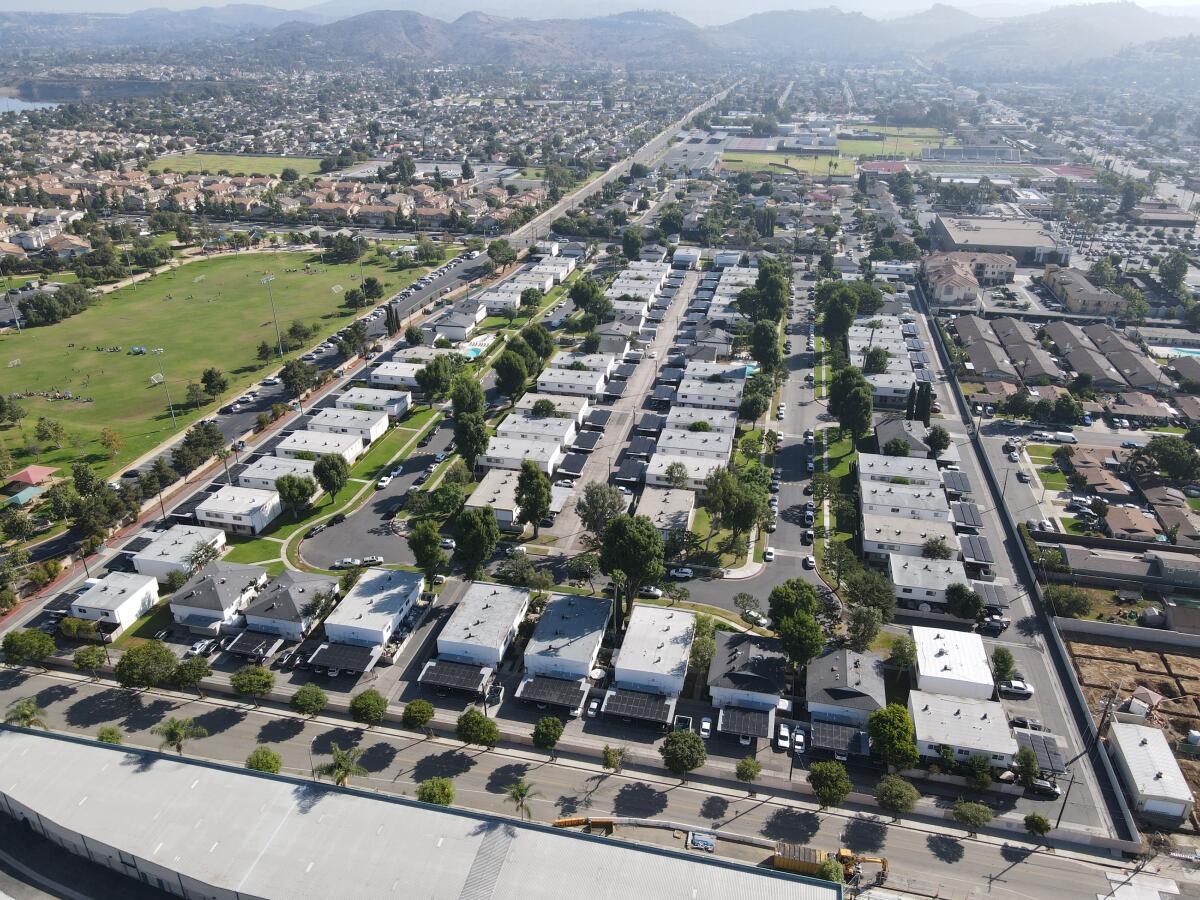
Other states have slashed rooftop solar incentives too, based on the argument that the payments mostly benefit higher-income homes, while contributing to larger electricity bills for families that can’t afford solar. Rooftop solar supporters disagree.
Whoever you think is right in that long-running debate, the difficult reality is we don’t have time to keep arguing. The climate emergency has arrived in full force. We need as much renewable energy as we can get, as fast as we can get it.
Fortunately, our poll found that 37% of voters want to see California move faster to replace fossil fuels with clean power. An additional 23% of respondents said we’re moving at about the right pace — which is not correct, sadly, but is better than suggesting we slow down. Just 29% of voters — mostly Republicans — said the state is moving too quickly to ditch coal, oil and natural gas.
No single poll can tell you everything, and this one is no different. Berkeley’s Institute of Governmental Studies administered it online in English and Spanish, surveying 6,342 registered voters from Oct. 24 to Oct. 30. The estimated margin of error is plus or minus 2 percentage points — an estimate that may be imprecise because of the weighting needed for an accurate sample.
And above all, a series of hypothetical yes-or-no questions can only go so far.
But on the whole, I’m optimistic. California is attempting to cajole the rest of the world into following our lead on climate. While there absolutely is more we should be doing, broad public support for renewable energy is a helpful starting point.
The trick now is for all those Californians who say they wouldn’t mind living near a solar farm, wind turbine or power line to make their voices heard when a developer comes to town — and not decide they’re opposed just because change is scary.
We’ll be back in your inbox Tuesday. To view this newsletter in your web browser, click here. And for more climate and environment news, follow @Sammy_Roth on Twitter.
Toward a more sustainable California
Get Boiling Point, our newsletter exploring climate change, energy and the environment, and become part of the conversation — and the solution.
You may occasionally receive promotional content from the Los Angeles Times.




